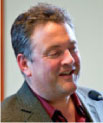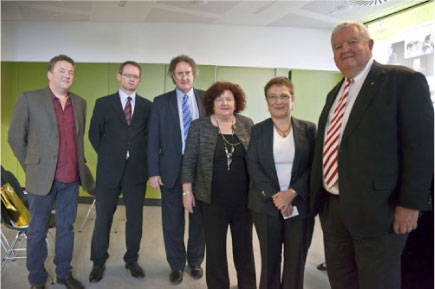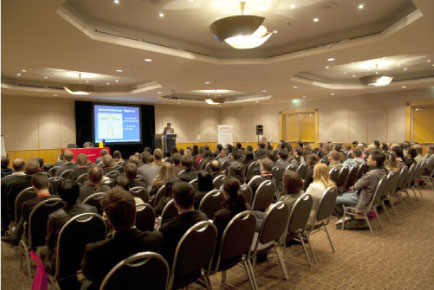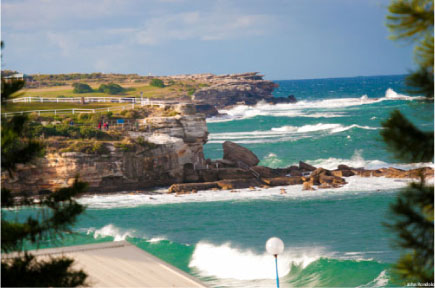Biomedical, Bio-Nano, Personalized Medicine – It’s All Nanomedicine to Us!
Tom DavisAustralian Centre for NanoMedicine, University of New South Wales, NSW 2052, Sydney, Australia. Email: t.davis@unsw.edu.au

Professor Tom Davis is a Director of the Australian Centre for NanoMedicine (ACN) as well as Director of the Centre for Advanced Macromolecular Design (CAMD) at The University of New South Wales. He is a highly regarded polymer chemist with experience from industry and academia. In more recent years, Professor Davis' research has moved towards polymers for biotechnology applications with a key interest examining the application of polymer nanotechnologies for drug delivery. Professor Davis is a former ARC Federation Fellow and has published more than 300 refereed papers, 11 book chapters and one co-edited book, Handbook of Radical Polymerization. He has made significant contributions to a number of fields, including hydrogels and soft contact lenses, pulsed laser polymerization (determination of rate constants), copolymerization mechanism, ring-opening polymerization, catalytic chain transfer, mass spectrometry of polymers, living radical polymerization, architecture control, glycopolymers, micro-patterned surfaces, nanoparticles, photochromism and most recently bio-hybrid nanostructures. He has trained more than 25 Ph.D. students, many of whom are now in senior positions in industry and academia. |
Australian Journal of Chemistry 65(1) 3-4 https://doi.org/10.1071/CH11491
Published: 19 January 2012
I have great pleasure writing this opening to the special edition of the Australian Journal of Chemistry dedicated to nanomedicine. Many of you would be aware that I have been a part of the Centre for Advanced Macromolecular Design (CAMD) for 10 years. It was a privilege when the Executive of UNSW asked me to establish and co-direct a new research centre in nanomedicine – The Australian Centre for NanoMedicine (ACN) (Fig. 1).

|
ACN has two key aims: first and foremost is as a research centre dedicated to finding solutions to provide a better way of life for those in our population afflicted with hard-to-treat diseases; and second to work with a diversity of stakeholder groups to communicate research findings and be an Australian hub for nanomedicine discussion and commentary.
Both of these aims were central to ACN hosting the 2nd International NanoMedicine Conference from 14 to 16 July 2011. As we spent three glorious Sydney winter days overlooking Coogee Beach as whales undertook their northern migration before us, 200 attendees representing over 25 invited speakers, 30 posters and 10 nationalities discussed their research under the headings of targeted delivery, diagnostics, imaging, sensing, nanosafety, regenerative medicine, and a special session on translational medicine.
For the second consecutive year, it was ACN’s pleasure to bring together the top minds in a discipline that crosses borders incorporating medicine, chemistry, and engineering and truly represents the adage of ‘bench to bedside’, but just as importantly ‘bedside to bench’.
The first of four plenary speakers opened the conference program, this being Professor Mark Kendall of the Australian Institute of Bioengineering and Nanotechnology (AIBN) with his address on Nanopatches for Target Vaccine Delivery to Skin: Improving Vaccines. Day 1 ended with what is becoming just as famous as the quality of the research presented at this conference – and that is the quality of our networking events. Day 1’s welcome event did not disappoint as nervousness and barriers quickly disappeared, and discussions and friendships developed. Three more outstanding plenary sessions followed, with speakers including Professor Calum Drummond, CSIRO’s Group Executive, Manufacturing, Materials and Minerals; Professor Ian Frazer, Chief Executive Officer and Director of Research at the Translational Research Institute (TRI) Pty Ltd (Fig. 2); and Professor Justin Gooding of the Australian Centre for NanoMedicine, UNSW. It was a deliberate decision that the plenary speakers showcased the very best of Australian nanomedicine research and researchers. But international participants were certainly heavily represented among our invited speakers, including in a special session highlighting up-and-coming early and mid-career researchers. This group of 10 researchers included Dr Nicolay Tsarevsky, Southern Methodist University, USA; Dr Julien Nicolas, University of Paris Sud, France; Dr Sidi Bencherif, Harvard University, USA; Dr Peter Wich, University of California Berkeley, USA; Dr Cecile Nouvel, Nancy University, France; Dr Simon Corrie, Australian Institute of Bioengineering and Nanotechnology, Australia; Dr Joshua McCarrol, Australian Centre for NanoMedicine, Australia; Dr Angus Johnston, The University of Melbourne, Australia; Dr Megan Lord, The University of New South Wales, Australia; and Dr Kristofer Thurecht, The University of Queensland, Australia.

|
Day 2’s conference program concluded with yet more social activities. First off was the presentation and support of 30 posters in the foyer of the Crowne Plaza Hotel. Following the poster display, ACN and CAMD PhD students arranged for attending PhD students to visit the local Coogee Beach nightlife (Fig. 3). I cannot overemphasise the need for these social activities to build cross-disciplinary and cross-institutional relations. But it was not until the final night of the conference that the awards and winners of the poster prizes were announced. NSW’s Chief Scientist and Chief Engineer, Professor Mary O’Kane, was the guest of honour at the conference gala dinner and tasked with presenting prizes to the best oral and poster presentations. Professor O’Kane’s department, the NSW Department of Trade and Investment, hosted the prizes which included:

|
-
Trade and Investment Early Career Researcher for Excellence in Nanomedicine Research – Oral: Dr Cindy Gunawan, The University of New South Wales
-
Trade and Investment Early Career Researcher for Excellence in Nanomedicine Research – Poster: Dr Seet Ruj Simon Ting, The University of New South Wales
-
Trade and Investment PhD Award for Excellence in Nanomedicine Research – Oral: Mr Shawn Stapleton, University of Toronto
-
Trade and Investment PhD Award for Excellence in Nanomedicine Research – Poster: Mr Kisha Roy, Deakin University
The Children’s Cancer Institute Australia (CCIA) awarded further honourable mention prizes which were presented by CCIA’s head of the Tumour Biology and Targeting Program, Professor Maria Kavallaris. Those winners were:
-
CCIA Honourable Mention prize for Early Career Researcher – Oral: Dr Hien Doung, Australian Centre for NanoMedicine
-
CCIA Honourable Mention prize for Early Career Researcher – Poster: Dr Mariana Beija, The University of New South Wales
-
CCIA Honourable Mention prize for PhD student – Oral: Mr Denison Chang, The University of Melbourne
-
CCIA Honourable Mention prize for PhD student – Poster: Mr Zhou (Jason) Deng, The University of Queensland
The dinner marked the end to three great days of discussion, which will all commence again from 2 to 4 July 2012. But the 2011 conference lives on through this special Research Front of the Australian Journal of Chemistry that comprises a selection of papers that epitomizes the current sentiments in this emerging field. The seven papers included come from attendees at the July 2011 conference – Nicolay Tsarevsky (Southern Methodist University, USA); Peter Wich (University of California Berkeley, USA); Hans Griesser (Ian Walk Institute, University of South Australia); John Hayball (University of South Australia); Neil Foster (The University of New South Wales); Mariusz Skwarczynski (The University of Queensland); and Jagat Kanwar (Deakin University).
What I am most pleased about is that we now scan through newspapers and news programs where virtually every day we hear or read about advances in the treatment of diseases, especially those diseases that may have meant a life sentence just a few years back. Today, our cutting edge research has enormous potential to influence future clinical care, especially for patients with cancer, diabetes, cardiovascular diseases, multiple sclerosis, Alzheimer’s and Parkinson’s disease, and inflammatory and/or infectious diseases. What is most exciting is that often the researchers are Australian researchers working in some of the world’s best research institutions and facilities. There is no doubt that Australia’s work in medical research, including nanomedicine, is world class.


